NCERT Notes for Class 11 History Chapter 3
| Textbook | NCERT |
| Board | CBSE Board, UP board, JAC board, HBSE Board, Bihar Board, PSEB board, RBSE Board, UBSE Board, EDC-IITG, IITG |
| Class | 11th Class |
| Subject | History |
| Chapter | Chapter 3 |
| Chapter Name | An Empire across Three Continents NCERT Notes for Class 11 History Chapter 3 |
| Topic | An Empire Across Three Continents class 11 Notes History |
| Medium | English |
| Especially Designed Notes for | CBSE, ICSE, IAS, NET, NRA, UPSC, SSC, NDA, All Govt. Exam |
An Empire across Three Continents NCERT Notes for Class 11 History Chapter 3, Between Christ’s birth and 630 CE, Rome and Iran held dominion over vast lands in Europe, North Africa, and the Middle East. Rome’s diverse territories united under a common government, its army both strength and challenge. Iran, led by Parthians and Sasanians, ruled an Iranian population, extending from the Caspian Sea to Afghanistan.
These empires had distinct social hierarchies; elites, middle class, and lower classes. Late antiquity brought economic growth, urban prosperity, and Christianity’s spread. However, external pressures and the rise of Islam caused the decline. Western Rome fragmented, while Eastern Rome (Byzantium) faced Islamic expansion. Their legacy continues to influence global history.
NCERT Notes for Class 11 History Chapter 3 An Empire Across Three Continents
An Empire Across Three Continents
It was the ancient Roman Empire which was spread across three continents namely Europe,
Asia and Africa.
Exploring Historical Sources:
- Historians are privileged to have a treasure trove of references that illuminate the stories of the Roman and Iranian Empires.
- These sources can be broadly classified into three categories: texts, documents, and material remains.
- Texts: The annals of history have been chronicled through a diverse range of textual sources.
- Histories penned by contemporaries, often referred to as “annals,” provide a year-by-year narrative of the past.
- Letters, speeches, treatises, laws, and other documents offer insights into the political, social, and legal landscapes of their time.
- Documents: Documentary sources include inscriptions and documents preserved on papyrus scrolls.
- These inscriptions, etched onto stone, provide glimpses into the language and customs of the era.
- Papyrus, a reed-like plant grown along the banks of the Nile, served as a prevalent writing material.
- Thousands of contracts, accounts, letters, and official documents have survived, revealing the daily life of ancient civilizations.
- Material Remains: Archaeological discoveries contribute to our understanding of history through material remains.
- These artifacts, unearthed through excavation and field surveys, offer a tangible connection to the past.
- From buildings and monuments to pottery, coins, and even aerially photographed landscapes, these remnants provide insights into ancient cultures and societies.
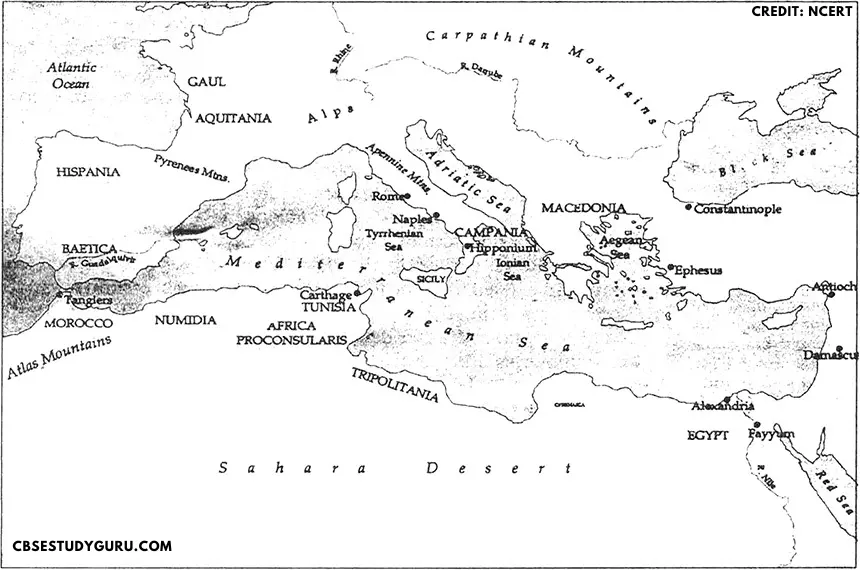
Empires in Focus:
Two powerful empires, Rome and Iran, shaped history with their expansive dominion and enduring rivalry.
Roman Empire
- The Roman Empire extended its dominion across a remarkable expanse, encompassing most of modern-day Europe, a significant portion of the Fertile Crescent, and North Africa.
Iran’s Influence:
- The Iranian Empire controlled vast regions to the south of the Caspian Sea, extending to eastern Arabia and, at times, encompassing significant portions of Afghanistan.
The empires of Rome and Iran were neighbors, sharing a narrow stretch of land along the Euphrates River.
Geographical Features:
- The Roman Empire’s heartbeat in the Mediterranean, The sea was like a pathway that helped the empire control Europe and Africa. Rome’s influence stretched north to the Rhine and Danube rivers, and its southern border was the Sahara Desert.
- The Iranian Empire’s influence radiated from the Caspian Sea to eastern Arabia, with occasional control over parts of Afghanistan. These two empires, divided by the Euphrates River, played a pivotal role in shaping the geopolitical landscape of their time.
Roman Empire | The Early Empire
The History of the Roman Empire can be divided into two clear-cut phases:
- The Early Empire, covering its start until the third century, marks a crucial period when the fundamental principles of the Roman state were put in place.
- The Late Empire, which emerged after the third century, represented a significant turning point marked by changing power dynamics and unforeseen challenges.
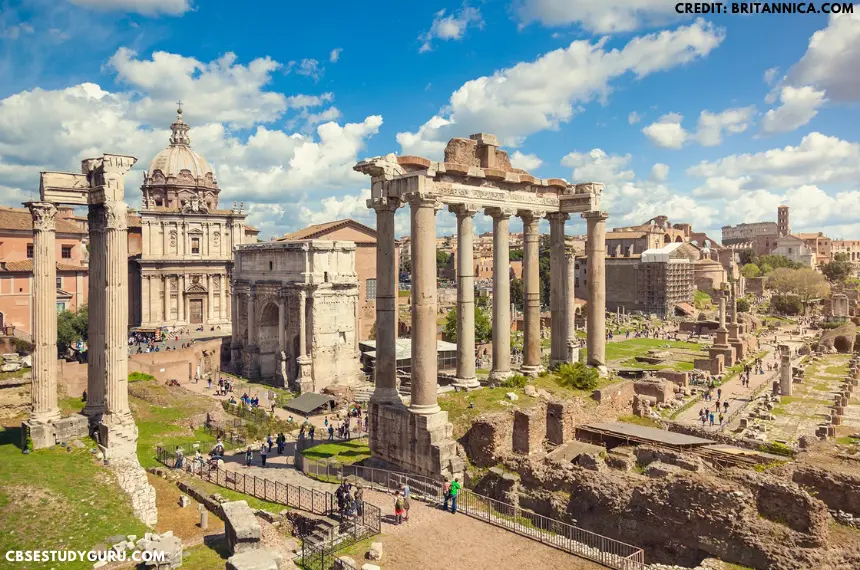
Difference between the Roman Empire and the Iranian Empire:
- A significant contrast between the Roman and Iranian Empires can be found in their cultural makeup.
- During this time, the Parthian and Sasanian dynasties, which held authority in Iran, predominantly ruled over the Iranian population.
- The Roman Empire presented a rich tapestry of territories and cultures united under a common governmental structure.
- In the Roman Empire, linguistic diversity was not just a facet of its identity but a reflection of its inclusive nature.
- While many languages resonated within its borders, two languages stood out as the pillars of administration: Latin and Greek.
- Latin and Greek were not merely languages of communication; they were the foundation upon which the administrative machinery of the empire was built.
- While the upper class of the East expressed themselves fluently in Greek, their Western counterparts favored Latin.
- A singular thread, however, bound all citizens – allegiance to a single emperor, transcending linguistic and geographical boundaries.
- Latin and Greek were the administrative languages, creating a bridge between the diverse linguistic regions.
The Principate and Senate:
- The establishment of the Principate by Augustus, the first emperor, in 27 BCE marked the beginning of the Early Empire.
- Despite being the sole ruler, Augustus maintained the fiction of being the ‘leading citizen,’ respecting the Senate’s historical significance.
- The Senate represented the aristocracy and played a crucial role in evaluating the behavior of emperors, making those who were hostile towards it appear as the worst rulers.
The Professional Army:
- The Roman army was a key institution in the Early Empire.
- Unlike the conscripted Persian army, Rome boasted a professional paid army, which became the largest organized body in the empire.
- Soldiers’ loyalty was essential, as their mutinies could influence the fate of emperors.
- Historians with senatorial biases often portrayed the army as a source of unpredictable violence, leading to tensions with the Senate.
Late Empire: Challenges and Transformation
- The Late Empire, which followed the third century, witnessed significant changes as the empire grappled with internal and external challenges.
Crisis and Transformation:
- The Late Empire faced economic, military, and political challenges, leading to a shift in power dynamics.
- The professional army, though powerful, could also contribute to civil unrest.
- The years of civil war, like the one in 69 CE, highlighted the impact of divided armies on stability.
Expansion and Contraction:
- In the early stages of the Roman Empire, external warfare was relatively less common due to its vast inherited territories.
- However, Emperor Trajan’s campaign of expansion across the Euphrates showcased a desire for conquest.
- The Late Empire saw the gradual absorption of dependent kingdoms into Roman provincial territory, particularly in the Near East.
Urban Centers and Provincial Elites:
- Urban centers, like Carthage, Alexandria, and Antioch, played a crucial role in the administration and taxation of the Roman Empire.
- The collaboration of local upper classes in administering their territories underscored the shift in power from Italy to the provinces.
- Provincial upper classes emerged as a new elite, supplying administrators and military commanders.
Synthesis
The Evolution of the Roman Empire The Roman Empire’s evolution was characterized by the interplay of culture, governance, and societal shifts between the Early and Late phases.
Key Players and Balance of Power:
- The emperor, the Senate, and the army were the primary players in the political history of the Roman Empire.
- Succession to the throne, based on family descent, often determined the empire’s direction.
- The control of the army played a decisive role in the success of individual emperors.
Decline of Italy, Rise of Provinces:
- The decline of Italy’s influence and the rise of provinces, driven by urbanization and the emergence of provincial elites, marked a significant shift in power dynamics.
- Emperor Gallienus’ exclusion of senators from military command exemplified the waning influence of the senatorial class.
The Third-Century Crisis
- Crisis Emergence:
- The third century brought a seismic shift to the Roman Empire.
- The crisis was defined by conflicts on multiple fronts and internal turbulence.
- Multi-Front Struggles:
- From the 230s onward, the empire grappled with simultaneous conflicts.
- The situation led to power struggles, both internal and external, reshaping the empire’s landscape.
- Rise of the Sasanians:
- In 225 CE, the Sasanian dynasty emerged in Iran.
- Unlike its predecessors, it was aggressive and expansionist.
- Within 15 years, the Sasanians rapidly expanded toward the Euphrates, threatening the eastern borders.
- Barbarian Onslaught:
- Concurrently, Germanic tribes and confederacies like the Alamanni, Franks, and Goths surged against the Rhine and Danube frontiers.
- From 233 to 280 CE, waves of invasions targeted provinces from the Black Sea to southern Germany.
- Whirlwind of Emperors:
- A stark indicator of the crisis was the rapid succession of emperors.
- In just 47 years, 25 emperors rose and fell. This succession underscores the strains the empire endured during this tumultuous period.
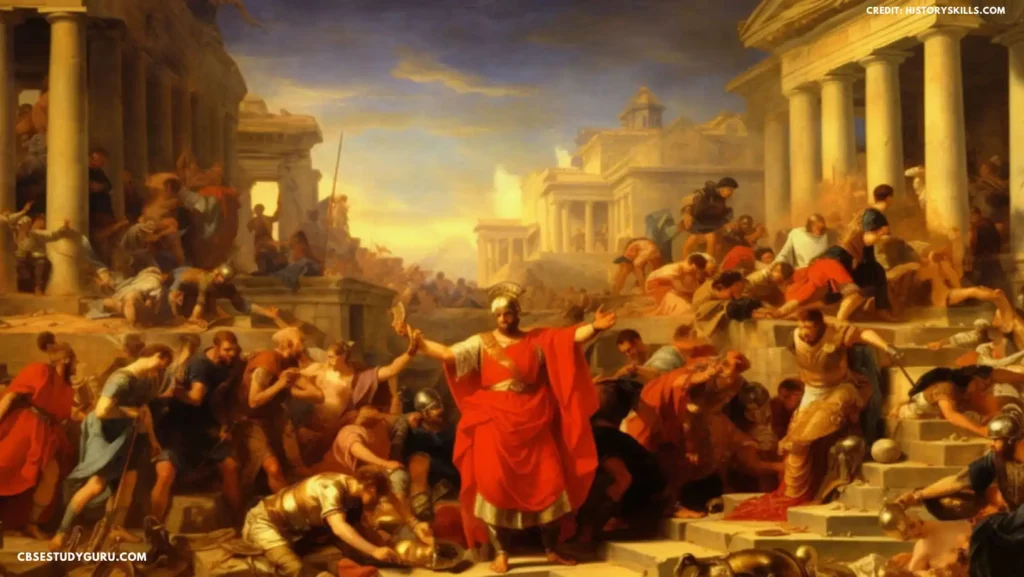
Gender, Literacy, Culture
Early Roman Society: A Tapestry of Family, Women, Literacy, and Culture
The Roman Empire
- The Roman Empire, a mosaic of territories and cultures, was primarily united by its system of government, with Latin and Greek serving as key administrative languages.
- The upper classes in the East preferred Greek, while the Western elites favored Latin.
- Regardless of their language or location, all inhabitants of the empire were subjects of the emperor.
Family Dynamics
- Roman society witnessed the prevalence of nuclear families, contrasting with extended family arrangements.
- Adult sons typically did not reside with their parents, and adult brothers sharing a household was rare.
- Notably, slaves were considered part of the family, emphasizing the Roman view of family.
Status of Women
- Roman women enjoyed remarkable legal rights when it came to property ownership and management.
- Marriages often took the form where wives retained full property rights from their natal families.
- Although women’s dowries went to their husbands during the marriage, they remained primary heirs to their fathers’ estates.
- In legal terms, a married couple was not a single financial entity but two independent ones.
- Divorce was relatively straightforward and could be initiated by either spouse.
- Marriages were often arranged, and some women faced domination or even violence from their husbands.
Literacy in the Roman Empire
- Literacy rates varied significantly across different regions of the empire.
- Some areas, like Pompeii, demonstrated widespread casual literacy with advertisements on walls and abundant graffiti.
- In contrast, Egypt, where numerous papyri survive, relied heavily on professional scribes for formal documents.
- Interestingly, these documents often mentioned individuals who were unable to read and write.
- Literacy was more common among specific groups, such as soldiers, army officers, and estate managers.
Cultural Diversity
- The Roman Empire’s cultural diversity was a defining feature, evident in various aspects of life.
- This diversity manifested in the multitude of religious cults and local deities worshipped.
- Languages spoken across the empire included Aramaic, Coptic, Punic, Berber, and Celtic, each with its regional prevalence.
- While some linguistic cultures were primarily oral, others developed scripts. For instance, Armenian began to be written in the fifth century, while Coptic translations of the Bible existed by the third century.
- Latin’s spread often displaced the written forms of other languages; Celtic, for example, ceased to be written after the first century.
- Beyond language, diversity was seen in dress, cuisine, social organization (tribal or non-tribal), and settlement patterns.
Economic Expansion of the Early Roman Empire
- The Roman Empire boasted an extensive economic infrastructure comprising harbors, mines, quarries, brickyards, olive oil factories, and more.
- Wheat, wine, and olive oil were the staple commodities traded and consumed on a massive scale.
- These goods primarily originated from specific regions: Spain, the Gallic provinces, North Africa, Egypt, and to a lesser extent, Italy. These regions were optimal for the cultivation of these crops.
- The transportation of liquids like wine and olive oil relied on containers called ‘amphorae.’
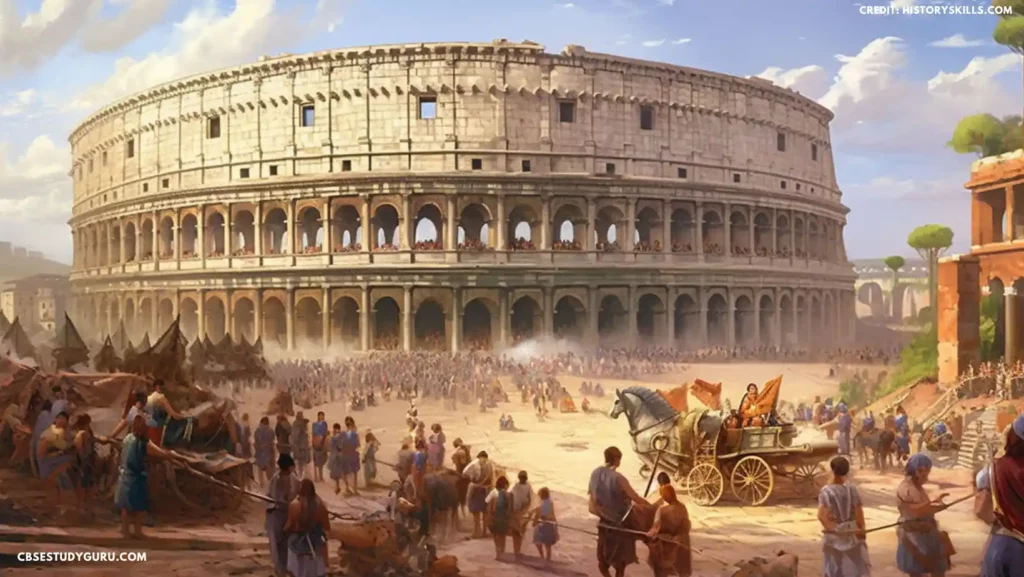
Olive Oil: A Thriving Enterprise
- The Roman Empire witnessed the zenith of the olive oil industry around 140-160 AD.
- Spanish olive oil, often carried in containers known as ‘Dressel 20,’ circulated widely throughout the Mediterranean.
- This success of Spanish olive growers was later replicated by North African producers during the third and fourth centuries.
- However, after 425 AD, North African dominance waned, giving way to regions in the East, including the Aegean, Southern Asia Minor (Turkey), Syria, and Palestine, as major exporters of wine and olive oil.
- The decline of African containers in Mediterranean markets indicated this shift.
- The prosperity of regions depended on effective production organization, transportation, and the quality of goods.
Regions of Fertility and Wealth
- The Roman Empire encompassed regions celebrated for their exceptional fertility and wealth.
- Campania in Italy, Sicily, the Fayyum in Egypt, Galilee, Byzacium (Tunisia), Southern Gaul (Gallia Narbonensis), and Baetica (Southern Spain) were recognized as among the most densely settled and prosperous areas, as noted by writers like Strabo and Pliny.
- Campania, in particular, was renowned for producing the finest wines.
- Sicily and Byzacium played significant roles in exporting large quantities of wheat to Rome.
- In these regions, water power was harnessed efficiently, advanced water-powered milling technology emerged, and hydraulic mining techniques were applied in Spanish gold and silver mines.
- Well-organized commercial and banking networks thrived, with money in widespread use. These factors underscore the sophistication of the Roman economy.
Underdeveloped Regions
- Conversely, vast expanses of Roman territory remained less developed.
- Transhumance, a pastoral and semi-nomadic lifestyle, prevailed in the countryside of Numidia (modern Algeria).
- These communities frequently migrated, bringing their distinctive oven-shaped huts, or ‘mapalia,’ along.
- The expansion of Roman estates in North Africa led to the drastic reduction of pastures for these communities, tightly regulating their movements.
- Even in Spain, the northern regions lagged economically and were predominantly inhabited by a Celtic-speaking peasantry residing in hilltop villages known as ‘castella.’
Controlling of Workers in the Roman Empire
Evolution of Labor Sources
- In the Republican period, large parts of Italy indeed relied heavily on slave labor. For instance, under Augustus, when the Italian population numbered 7.5 million, there were still three million slaves.
- Slaves represented a significant investment, and landowners sometimes cautioned against their use in situations requiring excessive numbers or where their health might be compromised, such as during disease outbreaks like malaria.
- As peace became established in the first century, the supply of slaves diminished. Those who required labor turned to alternatives: slave breeding or more economical substitutes, like wage labor.
- The Roman elites, often harsh towards their slaves, contrasted with ordinary people, who sometimes displayed more compassion.
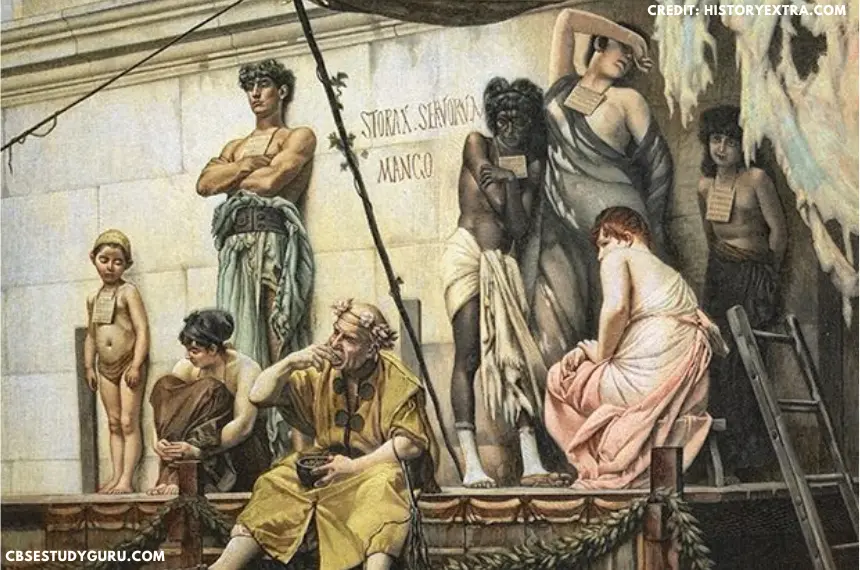
Transition to Wage Labor
- Slaves required continuous care and sustenance throughout the year, making their maintenance expensive.
- Public works in Rome predominantly employed free labor because extensive use of slave labor would have incurred prohibitively high costs.
- Free labor, however, was not without its challenges. A common presumption among employers was that work would not progress without close supervision, whether for free workers or slaves.
Supervision and Work Organization
- To facilitate supervision, workers were often organized into groups or teams. Columella, a first-century writer, recommended squads of ten, asserting that it was easier to assess individual effort within smaller workgroups.
- Pliny the Elder criticized the use of slave gangs as the worst method of organizing production. These slaves, typically chained together by their feet, worked in deplorable conditions.
Comparisons to Modern Labor Practices
- Though these ancient practices might seem draconian, parallels can be found in contemporary global labor standards. Many modern factories enforce similar principles of labor control.
Stringent Labor Conditions
1. Tight Supervision and Control
- Supervision Necessity: Romans believed that without constant supervision, work productivity would suffer. This principle applied to both free laborers and slaves.
- Gang Labor: Workers were often organized into gangs or smaller teams to enhance supervision. Columella recommended squads of ten, as they were easier to monitor for individual effort.
- Chaining Slaves: Slave gangs, although used, had a downside. Slaves working in gangs were often chained together by their feet, which the Elder Pliny criticized as the worst way to organize production.
2. Harsh Conditions in Specific Industries
- Frankincense Factories in Alexandria: Conditions in these factories were notoriously harsh. Workers had to wear sealed clothing, mesh masks or nets on their heads, and disrobe before leaving the premises.
- Agricultural Labor: Agricultural work was physically demanding and unpopular. Egyptian peasants, for example, left their villages to avoid it. Workers in this sector often faced stringent control measures.
3. Debt Contracts and Bondage
- Debt Contracts: Private employers often structured labor agreements as debt contracts. This arrangement allowed employers to claim that their employees were indebted to them, thus tightening control.
- Families in Debt Bondage: Many impoverished families resorted to debt bondage for survival. In some cases, parents sold their children into servitude for extended periods, such as 25 years.
4. Widespread Rural Indebtedness
- Historical Instances: Historical records show that rural indebtedness was widespread. During events like the great Jewish revolt of 66 CE, revolutionaries even destroyed moneylenders’ bonds to gain popular support.
5. Parallels with Modern Labor Control
- Modern Parallels: Despite their seeming harshness, the labor control principles applied in the Roman Empire find echoes in modern factories and industries worldwide. Strict supervision, worker organization, and contractual control persist in various forms today.
Emergence of Wage Labor
- Evidence from the papyri suggests that by the sixth century, wage labor had become widespread in parts of the Mediterranean, particularly in the East.
- An example of this transition is the construction of the eastern frontier city of Dara by Emperor Anastasius in less than three weeks. This was achieved by attracting labor from across the East with the promise of high wages.
Social Hierarchy in the Roman Empire
The Roman Empire’s social structure was multi-layered and underwent significant changes over time. Here’s a concise overview:
- Senators: At the top were the senators, the political elite of Roman society.
- Equestrian Class: Just below them were the equestrians, often wealthy and engaged in business.
- Respectable Citizens: This group had social status due to connections with aristocratic houses.
- Untidy Lower Class: Commoners who enjoyed the circus and theater formed this segment.
- Slaves: At the bottom were slaves, with minimal personal freedom.
Evolution of Social Hierarchy:
- Early third century: Roughly half of the senators were Italian.
- Late empire (early fourth century onwards): Senators and equestrians merged into an expanded aristocracy, with many families from Africa or the East.
- Late Roman aristocracy, though wealthy, often held less political power than military elites from non-aristocratic backgrounds.
The Middle Class:
- Emergence: A middle class developed within the evolving social structure.
- Composition: It comprised those involved in imperial service, including bureaucracy and the army. Additionally, prosperous merchants and farmers, especially in the eastern provinces, were part of this class.
- Patronage: Tacitus observed that this “respectable” middle class frequently served as clients for prominent senatorial households.
Income Disparities:
- Enormous Wealth: In the early fifth century, the Roman aristocracy in Rome earned staggering annual incomes, with some reaching up to 4,000 pounds of gold from their estates, excluding their direct consumption of produce.
- Second-Class Income: Meanwhile, second-class households in Rome had more modest incomes, typically ranging from one thousand to fifteen hundred pounds of gold.
Monetary System of the Late Empire:
- Transition to Gold: The late Roman Empire shifted from silver-based currencies, prevalent in earlier centuries, due to the exhaustion of Spanish silver mines and a shortage of silver reserves.
- Constantine introduced a new gold-based monetary system, resulting in the widespread circulation of gold coins.
Bureaucracy and Corruption:
The late Roman bureaucracy, both at higher and middle levels, was relatively affluent:
- Affluent Bureaucracy: The late Roman bureaucracy, both higher and middle tiers, received a substantial portion of their salaries in gold, often investing in land.
- Corruption Challenges: Corruption, notably in the judicial system and military supply administration, plagued the bureaucracy. Extortion by higher officials and provincial governors was notorious.
- Intervention and Denouncement: Government interventions and laws aimed to curb corruption, with historians and intellectuals actively denouncing such practices.
Roman Law and Civil Rights:
- Legal Restraint: Despite its authoritarian nature, the late Roman Empire had a robust tradition of Roman law by the fourth century. This legal framework acted as a check on the powers of emperors, protecting civil rights.
- Confronting Emperors: In the later fourth century, influential figures like Bishop Ambrose could confront even powerful emperors, challenging their treatment of the civilian population when it became excessively harsh or oppressive.
Late Antiquity: Transformations in the Roman World
Late antiquity, spanning the fourth to seventh centuries, marks a pivotal period in the evolution and decline of the Roman Empire.
Administrative Reforms by Emperor Diocletian
- Scaling Back Expansion: Emperor Diocletian recognized the need to scale back the overextended empire, strategically abandoning territories with limited strategic or economic value.
- Frontier Fortifications: Diocletian fortified frontiers, bolstering defenses against external threats.
- Civil-Military Separation: A significant change was the separation of civilian from military functions, granting military commanders (duces) greater autonomy.
Innovations by Emperor Constantine
- Monetary Reforms: Emperor Constantine introduced the solidus, a coin made of 4½ grams of pure gold, revolutionizing the monetary system. These coins were minted on a massive scale.
- New Capital: Constantinople, strategically located at the crossroads of Europe and Asia, was established as a new capital.
Economic Growth and Prosperity
- Monetary Stability: Late antiquity saw robust economic growth, driven by monetary stability.
- Rural Investments: Considerable investments were made in rural establishments, including industrial facilities like oil presses and glass factories.
- Technological Advancements: Innovations like screw presses and multiple water-mills contributed to economic expansion.
- Revival of Trade: Long-distance trade experienced a revival, further fueling urban prosperity.
Rise of the Ruling Elite
- Wealth and Power: Economic changes led to unprecedented urban prosperity, making the ruling elite wealthier and more powerful.
- Affluent Society: Historical records from Egypt reveal an affluent society with extensive monetary usage.
- Development in the Near East: Parts of the Near Eastern countryside were more developed and densely populated than in subsequent centuries.
Religious Transformation
- Christianity’s Ascendance: Emperor Constantine’s decision to make Christianity the official religion had a profound impact.
- Complex Shift: The shift from traditional polytheistic beliefs to Christianity was gradual and complex. Polytheistic traditions persisted in the western provinces.
Decline and Fragmentation of the Roman Empire
- Division: The Roman Empire was divided into eastern and western halves, with the Eastern Roman Empire experiencing more prosperity and expansion.
- Western Fragmentation: The Western Roman Empire fragmented as Germanic groups established their own kingdoms, foreshadowing the medieval era.
The Rise of Islam
- Arab Conquests: The rise of Islam in the seventh century initiated profound political changes. Arab conquests expanded rapidly, altering the political landscape.
- Unification of Arabia: The unification of the Arabian peninsula and tribes played a pivotal role in the territorial expansion of Islam.
NCERT Notes for Class 11 History
Ncert notes for class 11 history chapter 3: An Empire across Three Continents Timeline
| Rulers | Events |
| 284-305 the Tetrarchy; Diocletian main ruler | 434-53 Empire of Attila the Hun 493 Ostrogoths establish the kingdom in Italy533 -50 Recovery of Africa and Italy by Justinian |
| 312-37 Constantine | 354-430 Life of Augustine, bishop of Hippo |
| 309-79 reign of Shapur II in Iranians | 378 Goths inflict crushing defeat on Roman armies at Adrianople391 Destruction of the Serapeum (temple of Serapis) at Alexandria410 Sack of Rome by the Visigoths428 Vandals capture Africa |
| 541-70 Outbreaks of bubonic plague568 Lombards invade Italy. 570 Birth of Muhammad | 408-50 Theodosius II (compiler of the famous ‘Theodosian Code) |
| 490-518 Anastasius | 633-42 First and crucial phase of the Arab conquests; Muslim armies take Syria, Palestine, Egypt, Iraq and parts of Iran661-750 Umayyad dynasty in Syria698 Arabs captured Carthage711 Arab invasion of Spain. |
| 527-65 Justinian | 541-70 Outbreaks of bubonic plague |
| 531-79 reign of Khusro I in Iranians | 568 Lombards invade Italyc.570 Birth of Muhammad |
| 610-41 Heraclius | 633-42 The First and crucial phase of the Arab conquests; the Muslim armies taking Syria, Palestine, Egypt, Iraq, and parts of Iran661-750 Umayyad dynasty in Syria698 Arabs captured Carthage711 Arab invasion of Spain. |
Ncert notes for class 11 history chapter 3: An Empire across Three Continents FAQs
Ques. What do you understand by An Empire across Three Continents?
Ans.
The Roman Empire covered an expansive territory encompassing most of Europe, the Fertile Crescent, and North Africa.
This chapter delves into the empire’s organization, political dynamics, and social structures.
The Roman Empire boasted diverse local cultures and languages, and strong legal positions for women, but also relied heavily on slave labor.
By the fifth century, the Western part of the empire declined, while the Eastern part remained prosperous.
What is history in class 11?
In the realm of Class 11 history, the subject is a profound exploration of past events.
It encompasses the study of historical occurrences, often involving the memorization of key dates associated with pivotal moments in history.
To gain a comprehensive understanding, it is crucial to engage with the appropriate textbooks and resources.
Mention the area controlled by Iran?
The territorial expanse under Iranian control extended from the southern regions to the Caspian Sea, down to eastern Arabia, and encompassed a significant portion of Afghanistan.
This expansive dominion showcased the geopolitical influence and reach of ancient Iran.
What do you understand by the term Late Antiquity?
Late antiquity denotes the concluding and captivating period within the evolution and dissolution of the Roman Empire, spanning from the fourth to the seventh centuries.
This era bore witness to substantial transformations across cultural, economic, and administrative domains, shaping the course of history.
What were the Innovations of Emperor Constantine I?
Innovations by Emperor Constantine I
Emperor Constantine I left an indelible mark through his innovative endeavors:
Monetary Revolution: Constantine introduced the solidus, a coin crafted from 4½ grams of pure gold.
This groundbreaking currency was minted in vast quantities, revolutionizing economic transactions and trade.
The Birth of Constantinople: Another notable innovation was the establishment of a second capital at Constantinople. This strategically positioned city, situated at the crossroads of Europe and Asia, played a pivotal role in shaping the empire’s destiny.